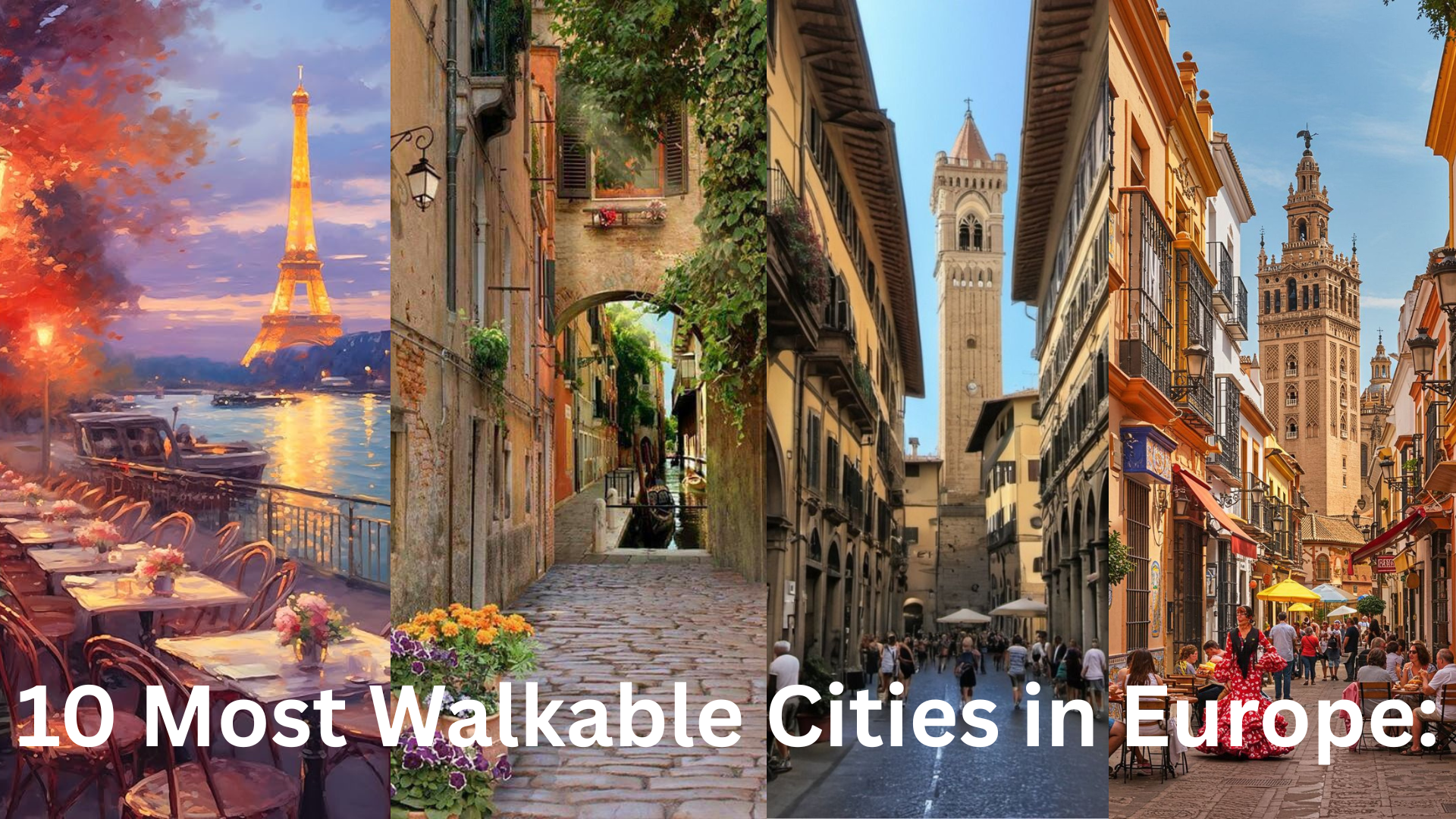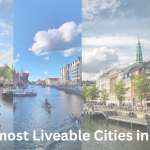Europe is a continent where history, culture, and modernity intertwine, and one of the best ways to experience its charm is by exploring its cities on foot. Walkable cities offer a unique blend of accessibility, pedestrian-friendly infrastructure, and compact layouts that make it easy to discover landmarks, hidden gems, and local culture without relying on cars or public transport. Based on recent studies and traveler insights, here are the 10 most walkable cities in Europe for 2025, each offering a delightful experience for those who love to stroll. This article dives into why these cities are perfect for pedestrians and what makes them stand out.
1. Seville, Spain 🇪🇸
Seville, the vibrant capital of Andalusia, tops the list as Europe’s most walkable city, with major attractions just 1.6 km apart, requiring about 2,100 steps to explore. The city’s historic center is a maze of charming alleys in the Barrio Santa Cruz neighborhood, leading to iconic landmarks like the Seville Cathedral, Real Alcázar, and Plaza de España. These sites, all UNESCO-listed, are within a 20-minute walk of each other, making Seville ideal for leisurely exploration. The flat terrain, pedestrian-only streets, and vibrant tapas culture encourage visitors to linger at local bars, soaking in the city’s Moorish heritage and flamenco rhythms. Seville’s warm climate and lively atmosphere make every step a sensory delight.
2. Venice, Italy 🇮🇹
Venice, a city built on canals, is a walker’s paradise, as cars are absent, and its compact layout ensures major sights are close together. With an average walking distance of 2 km between landmarks like St. Mark’s Basilica, Rialto Bridge, and Doge’s Palace, you can cover the highlights in about 27 minutes. The city’s narrow alleys and stone bridges create a magical experience, where getting lost is part of the charm. Venice’s pedestrian-only infrastructure, vibrant markets, and canal-side cafes make it perfect for slow travel. Be prepared for crowds, but early mornings offer quieter strolls through this timeless city.
3. Porto, Portugal 🇵🇹
Porto, known for its port wine and scenic Douro River, ranks third with its top attractions within 2.3 km, a 30-minute walk. The Ribeira District, with its colorful facades and riverside views, is a 5-minute stroll from São Bento Station. Key sites like the Clérigos Tower and Livraria Lello, one of the world’s most beautiful bookshops, are just 5–10 minutes apart. Porto’s hilly terrain adds a bit of challenge, but the compact city center and pedestrian-friendly streets make it rewarding. Stop for a pastel de nata and enjoy panoramic views from the Clérigos Tower.
4. Florence, Italy 🇮🇹
Florence, the cradle of the Renaissance, is a compact cultural hub where major landmarks like the Duomo, Uffizi Gallery, and Ponte Vecchio are within 0.5 miles of each other, a 10-minute walk. The city’s historic center is pedestrian-only, with narrow lanes bursting with art, history, and gelato stops. Florence’s flat terrain and excellent air quality make it ideal for walking, while its timeless architecture, from Michelangelo’s David to the Arno River’s bridges, captivates at every turn. It’s no wonder Florence has been named the world’s most walkable city in some studies.
5. Athens, Greece 🇬🇷
Athens, the birthplace of democracy, offers a walkable experience with iconic sites like the Acropolis, Parthenon, and Ancient Agora within 1.9 miles, about 30 minutes on foot. The city’s pedestrian-only Ermou Street and the lush National Garden add to its charm. Despite its size, Athens’ compact historic center makes it easy to explore ancient ruins and modern cafes alike. The flat terrain around key attractions and vibrant street life make Athens a walker’s delight, though summer visitors should bring water to beat the heat.
6. Amsterdam, Netherlands 🇳🇱
Amsterdam’s canal-lined streets and flat terrain make it highly walkable, with major sights like Dam Square, Anne Frank House, and the Van Gogh Museum within a 20-minute stroll (1.6 km). While famous for cycling, Amsterdam’s pedestrian paths along its 165 canals offer a scenic way to explore. The Jordaan neighborhood, with its quaint shops and cafes, is perfect for aimless wandering. A map is handy, as the canal layout can be disorienting, but getting lost here is a joy. The city’s bike trails and car-free zones enhance its walkability.
7. Milan, Italy 🇮🇹
Milan, Italy’s fashion capital, is surprisingly walkable, with 80% of residents living within 1 km of healthcare and education services. Key attractions like the Duomo, Galleria Vittorio Emanuele II, and La Scala are within a short stroll in the city center. The flat, pedestrian-friendly streets and vibrant urban design make Milan ideal for exploring on foot. From high-end boutiques to historic cafes, Milan’s compact layout and safety score make it a top choice for walkers seeking culture and style.
8. Verona, Italy 🇮🇹
Verona, the city of Romeo and Juliet, is a compact gem with its top attractions, including the Arena di Verona and Juliet’s House, within a short walk. The city’s pedestrian-only historic center, lined with Roman ruins and medieval architecture, is perfect for leisurely strolls. Verona’s flat terrain and charming piazzas, like Piazza delle Erbe, invite visitors to linger. Its smaller size compared to Florence or Venice makes it less crowded but equally enchanting, ideal for romantic walks along the Adige River.
9. Nice, France 🇫🇷
Nice, on the French Riviera, combines coastal beauty with walkable urban charm. The Promenade des Anglais, Old Town, and Place Masséna are within a 15-minute walk, covering about 1 km. The flat terrain, pedestrian-friendly streets, and Mediterranean vibe make Nice perfect for strolling. Explore colorful markets, enjoy Niçoise cuisine, or wander the narrow alleys of Vieux Nice. Nice’s excellent safety score and vibrant street life make it a delightful destination for pedestrians.
10. Bruges, Belgium 🇧🇪
Bruges, a medieval fairytale town, is crowned Europe’s most walkable city by some studies, with its top attractions, like the Belfry and Bruges Beer Experience, within 2.3 km, a 29-minute walk. Canals, cobbled streets, and Gothic architecture create a magical setting for pedestrians. The compact historic center, with minimal elevation, is ideal for all ages. Stop for Belgian chocolate or waffles as you explore this UNESCO World Heritage Site, where every corner feels like a postcard.
Why Walkable Cities Matter
Walkable cities like these offer more than convenience—they promote sustainability, health, and authentic cultural experiences. Europe’s pedestrian-friendly urban designs, often rooted in pre-automobile eras, create dense, vibrant centers where attractions, cafes, and services are close together. Studies show that cities like Zurich and Milan, with over 95% of residents within a 15-minute walk of essential services, enhance quality of life. Walking reduces carbon footprints, encourages local interactions, and uncovers hidden gems that cars or buses might miss.
Tips for Exploring on Foot
To make the most of these walkable cities, wear comfortable shoes, as cobbled streets can be uneven. Carry a map or use offline apps like Google Maps, especially in maze-like cities like Venice. Start early to avoid crowds, and take breaks at cafes or parks to soak in the atmosphere. Check weather forecasts, as rain can make walking less enjoyable, though cities like Bruges and Amsterdam shine even in drizzle. Finally, embrace spontaneity—wandering often leads to the best discoveries.
Conclusion
Europe’s most walkable cities—Seville, Venice, Porto, Florence, Athens, Amsterdam, Milan, Verona, Nice, and Bruges—offer a perfect blend of history, culture, and accessibility. From Seville’s sunny plazas to Bruges’ medieval charm, these destinations reward those who explore on foot with unforgettable experiences. Whether you’re drawn to Renaissance art, ancient ruins, or canal-side cafes, these cities make every step a journey. Lace up your shoes, hit the streets, and discover the heart of Europe at a pedestrian’s pace.














